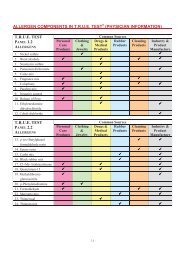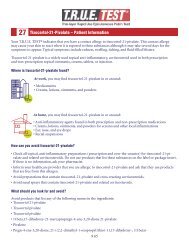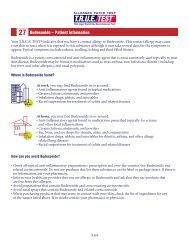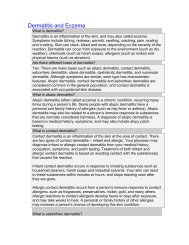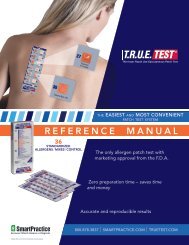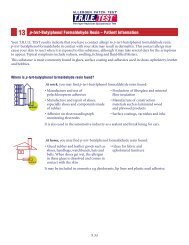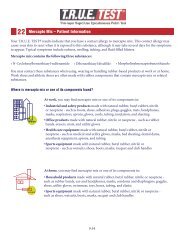2013 Re: T.R.U.E Test and gold Dear Health Care Professional ...
2013 Re: T.R.U.E Test and gold Dear Health Care Professional ...
2013 Re: T.R.U.E Test and gold Dear Health Care Professional ...
Create successful ePaper yourself
Turn your PDF publications into a flip-book with our unique Google optimized e-Paper software.
patch. Allergies to parthenolide occur frequently in gardeners <strong>and</strong> greenhouse employees, but non-occupational contact with plants <strong>and</strong> herbal teas containingsesquiterpenes also occurs.Disperse Blue 106 (DB106) (Position 35):Disperse blue 106 (purity ≥ 90%) is a commonly used thiazol-azoyl-p-phenylene diamine derivative dye used primarily in synthetic textiles <strong>and</strong> is a significantskin sensitization hazard. The product is formulated to contain 50 mcg/cm 2 of disperse blue 106, which corresponds to 41 mcg of disperse blue 106 per patch.The gel vehicle is povidone. Together with Disperse blue 124, it has been determined to be the primary cause of textile dermatitis.2-Bromo-2-nitropropane-1,3-diol (Bronopol) (Position 36):2-Bromo-2-nitropropane-1,3-diol (purity ≥ 95%) is an antimicrobial agent commonly used as a preservative in many types of cosmetics, personal careproducts, <strong>and</strong> topical medications. The gel vehicle is povidone. The product is formulated to contain 250 mcg/cm 2 of 2-Bromo-2-nitropropane-1,3-diol, whichcorresponds to 203 mcg of 2-Bromo-2-nitropropane-1,3-diol per patch.12. CLINICAL PHARMACOLOGYA positive response to the patch test is a classic delayed cell-mediated hypersensitivity reaction (type IV), which normally appears within 9 to 96 hours afterexposure. Following primary contact, an allergen penetrates the skin <strong>and</strong> binds covalently or noncovalently to epidermal Langerhans cells. The processed al-38



